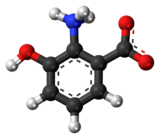Chemistry:3-Hydroxyanthranilic acid
From HandWiki

| |

| |
| Names | |
|---|---|
| Preferred IUPAC name
2-Amino-3-hydroxybenzoic acid | |
| Identifiers | |
3D model (JSmol)
|
|
| ChEBI | |
| ChEMBL | |
| ChemSpider | |
| DrugBank | |
| KEGG | |
| MeSH | 3-Hydroxyanthranilic+Acid |
PubChem CID
|
|
| UNII | |
| |
| |
| Properties | |
| C7H7NO3 | |
| Molar mass | 153.137 g·mol−1 |
| Appearance | powder |
| Density | ≈ 1 g/cm3 |
| Melting point | 240–265 °C (464–509 °F; 513–538 K)[3] decomposes 227 °C (441 °F; 500 K)[2] from dilute HCl, decomposes |
| low[1] | |
| Solubility | soluble in ether, CHCl3, alcohols[1] |
| Solubility in hydrochloric acid | 1 N:[1] 1 g/100 ml |
| Acidity (pKa) | at 20 °C:[2] 1 = 2.7, 2 = 5.19, 3 = 10.12 |
| UV-vis (λmax) | 298 nm[2] |
Except where otherwise noted, data are given for materials in their standard state (at 25 °C [77 °F], 100 kPa). | |
| Infobox references | |
Tracking categories (test):
3-Hydroxyanthranilic acid is an intermediate in the metabolism of tryptophan. It is new antioxidant isolated from methanol extract of tempeh. It is effective in preventing autoxidation of soybean oil and powder, while antioxidant 6,7,4'-trihydroxyisoflavone is not.[4]
References
- ↑ 1.0 1.1 1.2 "3-Hydroxyanthranilic acid". Santa Cruz Biotechnology, Inc.. https://www.scbt.com/scbt/product/3-hydroxyanthranilic-acid-548-93-6.
- ↑ 2.0 2.1 2.2 Armarego, Wilfred L.F.; Chai, Christina L.L. (2009). Purification of Laboratory Chemicals (6th ed.). Elsevier Inc.. p. 297. ISBN 978-1-85617-567-8. https://books.google.com/books?id=PTXyS7Yj6zUC&pg=PA297.
- ↑ Moline, Sheldon W.; Walker, H.C.; Schweigert, B.S. (1958). "3-Hydroxyanthranilic Acid Metabolism: VII. Mechanism of Formation of Quinolinic Acid". Journal of Biological Chemistry 234 (4): 880–883. doi:10.1016/S0021-9258(18)70194-4. PMID 13654282. http://www.jbc.org/content/234/4/880. Retrieved 2015-09-24.
- ↑ Esaki, Hideo; Onozaki, Hiromichi; Kawakishi, Shunro; Osawa, Toshihiko (1996). "New Antioxidant Isolated from Tempeh". Journal of Agricultural and Food Chemistry 44 (3): 696. doi:10.1021/jf950454t.
External links
- HAA concentration graph in lyophilized tempeh powder extract (in Indonesian)
 |

